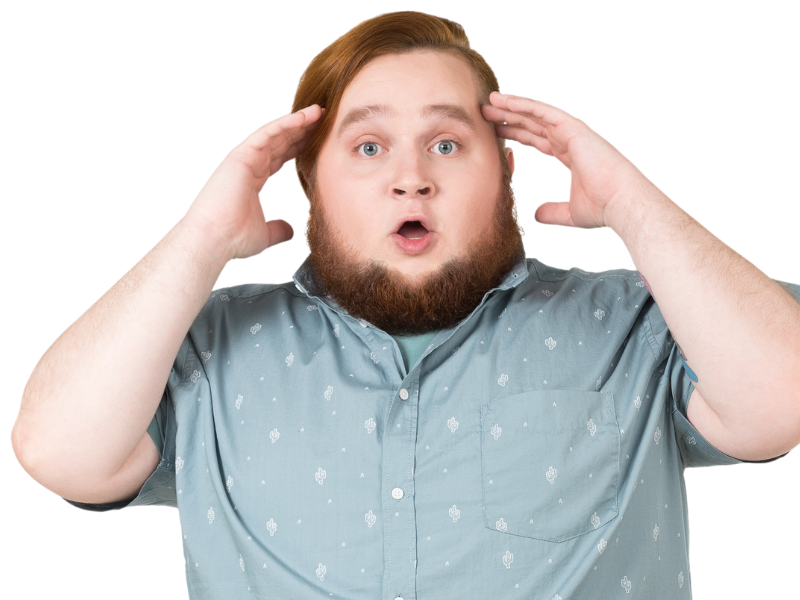Although nearly 40 million people in the United States struggle with migraines on a regular basis, only 1% of migraineurs get hemiplegic migraines. About 25% of migraine patients experience aura.1 But only about 0.01% of the population suffers from hemiplegic migraine.2
What is a hemiplegic migraine?
The word hemiplegic derives from hemiplegia, which means paralysis on one side of the body. During a hemiplegic migraine attack, a person might have the same symptoms as a regular migraine – severe head pain, light sensitivity, nausea, vomiting – but will also experience temporary unilateral weakness or even full-blown paralysis. Hemiplegic migraines are one of the rarest and most severe types of migraine. It is a subtype of “migraine with aura.” Aura are neurological symptoms people with migraine may experience before or during a migraine attack. For many, this manifests as visual disturbances such as flashing lights, zigzag lines, or blind spots.
What causes hemiplegic migraines?
Hemiplegic migraine is thought to be due to genetic mutations in three genes that affect the release of neurotransmitters. These mutations hinder communication between nerve cells. This may lead to symptoms of hemiplegic migraine.
There are two distinct types of hemiplegic migraine:
- Familial hemiplegic migraine (FHM) is due to abnormal variations on either the CACNA1A gene, ATP1A2 gene, or SCN1A gene. These genes produce proteins needed for the normal functioning of nerve cells. Children of hemiplegic migraine have a 50% chance of developing it themselves.4
- Sporadic hemiplegic migraine (SHM) is when someone without a family history develops hemiplegic migraine.
Current theories are that specific mutations or disruptions in these genes may make a person more likely to develop this type of migraine. This is because as many as half of the people who are diagnosed with hemiplegic migraines inherited one of these genes from a parent. However, there’s also evidence that people without these genetic mutations can get them, too.
As with other forms of migraine, hemiplegic migraine attacks can be triggered by:
- Stress
- Lack of sleep
- Dehydration
- Weather changes
- Skipping meals
- Certain ingredients, additives, foods, and drinks
- Physical exertion
- Female hormones
- Smoke and alcohol
- Caffeine
- Certain medications
- Lights and sound
Hemiplegic migraine also has some connections to head trauma. In fact, in one study 24% of patients reported a head injury preceded their first migraine attack.5
Symptoms may last anywhere between a few hours or days, or in rare cases weeks! On average, the onset of symptoms begins between ages 12 to 17.2 Although in some cases, symptoms may show up much earlier. Symptoms typically fade in intensity with age, especially after age 50.
What are the symptoms of hemiplegic migraines?
Hemiplegic migraines share many symptoms with ‘regular’ migraines and may or may not include:
- Intense, throbbing head pain, typically restricted to one side
- Sensitivity to light, sound, and/or smell
- Nausea and vomiting
- Tunnel vision, double vision, seeing flashes of light, or blind spots
- Heavy or tingling sensation in the arms and legs (pins and needles feeling)
- Slurred speech or difficulty speaking
- Dizziness

Additionally, hemiplegic migraines can cause distinctive symptoms ranging from mild to severe, such as:
- Numbness on one side of the body
- Weakness or paralysis on one side of the body, which can include one half of the face, arm, and/or leg
- Loss of coordination
- Fever
- Confusion and lethargy
- Memory loss
- Coma
The symptoms of hemiplegic migraines can last anywhere from a few hours to several days (or even weeks, on rare occasions). In many cases, symptoms can get bad enough that the person experiencing them may believe that they are suffering from a stroke.
Since it’s nearly impossible to tell the difference between a hemiplegic migraine and a stroke without a proper examination, it’s important to seek immediate medical attention or call 911 if you are experiencing any of the following symptoms during a migraine attack:
- Trouble speaking or understanding what people are saying
- Slurred speech
- Loss of consciousness
- Sudden numbness or muscle weakness
- Seeing double in one or both eyes
- Fainting or seizure
Occasionally, attacks may cause severe symptoms including:
- Confusion
- Loss of consciousness
- Paralysis on one side of the body
Call 911 if you experience any severe symptoms. Hemiplegic migraine patients are at an increased risk of stroke and symptoms often mimic one another.3 In some rare cases, severe attacks led to cerebral atrophy, permanent brain injury, and even coma.2 So getting immediate medical attention is critical.
Migraine vs. Stroke
While symptoms may be similar, during a stroke, blood flow to part of your brain is cut off. The cells in the brain that don’t get enough oxygen begin to die. There can be two causes of stroke. Either a blood vessel is blocked such as with a blood clot, or a blood vessel tears or bursts and causes bleeding in or around the brain. The kind of stroke that tends to be mistaken for a migraine is called a transient ischemic attack, or TIA. It’s also known as a “mini stroke” because blood flow to your brain is cut off only for a short time. Symptoms are less severe than with a regular stroke and may last less than an hour.
Can a hemiplegic migraine lead to a stroke?
Hemiplegic migraines have not been shown to cause strokes. However, it is important to point out that getting any kind of migraine with aura can double your risk of suffering from a stroke or heart attack, according to a large-scale longitudinal study.
How to get diagnosed
Getting diagnosed with hemiplegic migraine can be tricky. Diagnosis is based on symptoms, along with a detailed health history. Since hemiplegic migraine has a strong genetic component, a thorough family history is needed as well. Diagnosis criteria include having episodic, reversible weakness on one side of the body, along with at least one other kind of aura.
CT scans and MRIs are often done to rule out other health conditions. Typically, people with hemiplegic migraine have normal brain imaging. However, a small portion of patients may show atrophy of the cerebellum.6
Hemiplegic Migraine Treatment: What Are Your Options?
Living with hemiplegic migraine can be scary. Migraine attacks can strike anytime. And while migraine attacks are never fun, hemiplegic migraine attacks are especially intense.
So let’s dive into some treatment options that may help you manage or even prevent future migraine attacks. Remember – always work with your doctor to find a treatment plan that’s ideal for your own body and lifestyle.
Medications
Your doctor may prescribe over-the-counter meds such as NSAIDS to manage the pain. Anti-nausea medications may be prescribed for related symptoms. Triptans and ergotomines are often prescribed for other forms of migraine. But they’re NOT recommended for hemiplegic migraine, as they can increase the risk of stroke.2
Many medications interact and symptoms of hemiplegic migraine are intense. So preventative treatments using lifestyle and supplements can be invaluable.
Lifestyle Habits
Prevention is the best medicine when it comes to hemiplegic migraine. Practicing healthy lifestyle habits helps limit your triggers, lessening the frequency of attacks. Here are some lifestyle habits that may help prevent future migraine attacks:
- Avoid trigger foods such as alcohol, caffeine, chocolate, nitrates, and MSG. Staying away from processed foods is a good place to start.
- Exercise regularly but don’t overdo it. Remember, too much physical exertion may trigger an attack. Start with walking, yoga, or stretching, and work your way up from there.
- Manage stress with calming activities such as meditation, mindfulness, breathing exercises, or journaling.
- Don’t skip meals and always have snacks on hand. Low blood sugar can trigger migraine attacks. Fasting may be trendy, but it’s NOT for everyone!
- Get enough sleep, but not too much. If you struggle with sleep, consider a natural sleep aid.
Supplements
Research shows certain vitamins, minerals, and herbs can reduce the number of migraine attacks in patients. Here are the top defenders:
- Magnesium is a mineral involved in over 300 enzymatic reactions in your body! Unfortunately, magnesium deficiency is extremely common in people with migraine. Over time, low magnesium can lead to depression, anxiety, and insomnia. Stress also depletes the body of magnesium and living with migraine is certainly stressful! Supplementation can help you replenish your stores.
- Riboflavin (aka vitamin B2) plays a key role in helping your mitochondria produce cellular energy. Research has shown that a mitochondrial defect may reduce an individual’s threshold to migraine triggers and lead to migraines. A deficiency of mitrochondrial energy reserves has been observed in many people exhibiting poor cerebrovascular tone.
- Feverfew has been recorded as a medicinal remedy for millennia. Its anti-migraine effects are believed to be due to its potent anti-inflammatory properties and its ability to reduce blood platelet aggregation.
Takeaway
A hemiplegic migraine is a rare form of migraine headache that causes temporary weakness or paralysis to one side of the body. Sometimes hemiplegic migraines can resemble a stroke, so if you experience muscle weakness or paralysis, trouble speaking, and vision changes, it’s important to seek immediate medical attention to rule out other conditions.
If you have recurrent migraines, talk to a doctor to ensure you have an action plan for when an attack hits. It may also be a good idea to discuss your diet and lifestyle habits to see if there’s anything you could do to reduce the frequency or severity of migraine episodes in the future. For more information on migraine treatment options, download the Migraine White Paper.
References:
1 https://www.ncbi.nlm.nih.gov/books/NBK554611/
2 https://www.ncbi.nlm.nih.gov/books/NBK513302/
3 https://www.ncbi.nlm.nih.gov/pmc/articles/PMC5346116/
4 https://www.ncbi.nlm.nih.gov/books/NBK1388/
5 https://www.ncbi.nlm.nih.gov/pmc/articles/PMC6803542/
6 https://www.ncbi.nlm.nih.gov/pmc/articles/PMC5944084/
7 https://pubmed.ncbi.nlm.nih.gov/22426836/
8 https://pubmed.ncbi.nlm.nih.gov/15257686/
9 https://www.ncbi.nlm.nih.gov/pmc/articles/PMC8105190/


